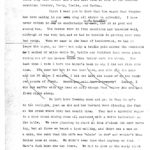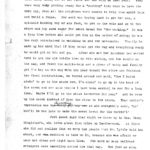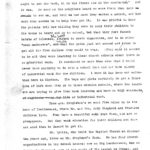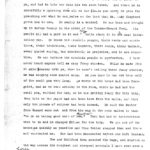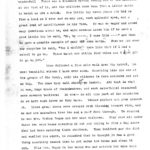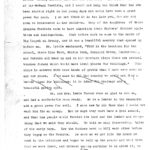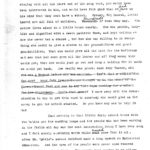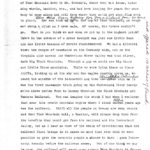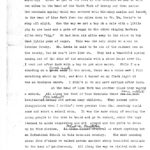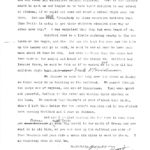Pine Mountain Settlement School
Series 07: Directors
Katherine Pettit

… Lewis Lyttle letter to Katherine Pettit, May 9, 1911, p. 1 of 5. [lyttle_pettit_1911_001.jpg]
DEAR FRIEND LETTER 1911 Katherine Pettit – My Dear Friend Letter, May 27
TAGS: Dear Friend Letters, Katherine Pettit, correspondence ; My Dear Friend Letters ; Katherine Pettit ; Stephen Guilford ; Harriet Butler ; Rev. Lewis Lyttle ; Hindman, KY ; community members ; church mission schools ; industrial education ; smallpox ; land donations ; Turner Family ; railroads ; WCTU Settlement School ; Creech Family ; William Lewis Family
This is a transcription of an original draft of MY DEAR FRIEND LETTER that Katherine Pettit composed to assist in raising funds for the building of Pine Mountain Settlement School. It was most likely shared with Ethel de Long to help her compose the May 29, 1911, DEAR FRIEND LETTER.
In this typewritten draft, which contain Pettit’s original corrections and annotations, dated May 27, 1911, Miss Katherine Pettit describes a trip that she, Rev. Lewis Lyttle, Stephen Guilford (a former Hindman Settlement School student) and Miss Harriet Butler, a nurse from Hindman, made to Letcher, Perry, Leslie, and Harlan counties following an appeal from Rev. Lyttle. Their goals for the excursion were to view the Pine Mountain site proposed by Rev. Lyttle for a new school and for Pettit to visit homes where “coverlids” (bed covers) were woven, a handicraft in which she had a strong interest.
Sometime later, when Pettit and Ethel de Long‘s plans were becoming more fully formed and they began prospecting for donations to their cause, Pettit appears to have dredged up her notes from the early trip with Lyttle and assisted de Long in re-writing the “MY DEAR FRIEND Letter,” including de Long as one of the travelers. (Ethel de Long had accompanied Pettit in a 1910 visit to Pine Mountain, according to a Lyttle’s narrative in the 1944 PINE MOUNTAIN FAMILY ALBUM.)
The new school was planned to be a satellite settlement of Hindman and was hoped to be a resource for children deep in the Harlan and Letcher County area of Eastern Kentucky. Pettit makes it clear that she envisions the new school to be an Industrial Training program that would provide an alternative to the boarding schools being established in the nearby towns.
The two letters, one by Pettit dated 1911 and the other by de Long, also dated 1911, are confusing because, in reality, they did not take place during the same time frame. Instead, the earlier Pettit letter had been melded into the later one by de Long with the purpose to move donors and build a fund to establish the school that had long been on the mind of Katherine Pettit. Her dream was inspired by Lewis Lyttle and Pettit’s knowledge of the work of earlier school founders such as the Rev. E.O. Guerrant, Stuart Robinson, Witherspoon College and others in the area.
Pettit’s trip began on a very hot day. On that day Pettit, Harriet Butler, and Guilford started out in a horse-drawn wagon which Guilford had built at Hindman and which they later had to leave behind at the head of Leatherwood to use a bridle path. Somewhere along the way, they met Rev. Lyttle. After leaving the wagon they walked 29 miles “… while Mr. Lyttle and Guilford took turns about riding one of the horses and Miss Butler rode the other.” — no word on Pettit.
By Tuesday noon, they arrived at twilight at Mary Stacy‘s home, where they ate fish just caught by Mr. and Mrs. Stacy in the creek. At 4 a.m. during their overnight stay, a man on a mule called out that his wife was dying and asked for Miss Butler to come at once. Miss B. went 2 miles up the creek with him. She returned at 7 a.m. saying the woman was better. So they left later that morning to continue their journey several hours later than they had planned. They started out along Carr’s Fork to the North Fork of the Kentucky River. “At the River we found the road quite bewildering because of the grading and blasting for the new railroad … ”
Continue below for scanned images of Katherine Pettit’s annotated and edited letter to MY DEAR FRIENDS, followed by the transcription of the full story.
GALLERY: KATHERINE PETTIT CORRESPONDENCE 1911 My Dear Friend Letter
- 0001 Pettit Correspondence, May 27, 1911. [1911_pettit_ltr_0001-1.jpg]
- 0002 Pettit Correspondence, May 27, 1911. [1911_pettit_ltr_0002-1.jpg]
- 0003 Pettit Correspondence, May 27, 1911. [1911_pettit_ltr_0003-1.jpg]
- 0004 Pettit Correspondence, May 27, 1911. [1911_pettit_ltr_0004-1.jpg]
- 0005 Pettit Correspondence, May 27, 1911. [1911_pettit_ltr_0005-1.jpg]
- 0006 Pettit Correspondence, May 27, 1911. [1911_pettit_ltr_0006-1.jpg]
- 0007 Pettit Correspondence, May 27, 1911. [1911_pettit_ltr_0007-1.jpg]
- 0008 Pettit Correspondence, May 27, 1911. [1911_pettit_ltr_0008-1.jpg]
- 0009 Pettit Correspondence, May 27, 1911. [1911_pettit_ltr_0009-1.jpg]
- 0010 Pettit Correspondence, May 27, 1911. [1911_pettit_ltr_0010-1.jpg]
TRANSCRIPTION: KATHERINE PETTIT CORRESPONDENCE 1911 My Dear Friend LETTER
Page 1 – [1911_pettit_ltr_0001-1.jpg
[This text has been lightly edited.]
Hindman, Knott County, Kentucky, May 27, 1911
My dear Friend:-
At last there is a chance to tell you about that beautiful trip Miss Butler and I had last week in four of our mountain counties: Letcher, Perry, Leslie, and Harlan.
First I want you to know that the wagon that Stephen has been making in our shop all winter is splendid. I have never ridden in one so comfortable in the mountains, and it is good and strong too. The horses were in fine condition and traveled well, although it was very hot, and we had no trouble in getting over very bad roads. When we came to the head of Leatherwood, we had to leave the wagon, as there was only a bridle path across the mountains. I walked 29 miles while Mr. Lyttle and Guilford [?] took turns about riding one of the horses and Miss Butler rode the other. The last time I rode I hurt the horse’s back is why I did not ride this time. [The following is crossed out by Pettit who was always sensitive about her weight.] You know how hot it was last week, and with all the heat and the 29 miles I walked, I did not lose one ounce of my two hundred pounds of flesh. Don’t you call that a tragedy? Indeed, I did not suffer with the heat at all, though Miss Butler did and lost flesh right along.
We left here Tuesday noon and got to Mary Stacy’s in the twilight, just as she and her husband were cleaning the fish at the creek where they had caught them. They had a splendid supper in a nice clean dining room all screened, with a white tablecloth on the table. We were planning to start at four o’clock the next morning, but at three we heard a loud calling, and there was a man on a mule, who said that his wife was “aimin’ to die” and wouldn’t Miss Butler come at once. We didn’t even know that anybody on that Carr’s fork knew she was there. We had to give up the early start and Miss Butler went two miles up the creek with him; at seven o’clock she was back saying the woman was better and we started on down Carr to the North Fork of the Kentucky River. At the River we found the road quite bewildering because of the grading and blasting for the new railroad. We constantly had to be getting out and …
Page 2 – [1911_pettit_ltr_0002-1.jpg]
… holding the horses and wait for the blasting. We were glad to get off the river and go all the way up to the head of Macey’s Creek through beautiful wild country. We stopped and rested for an hour with Carry Hall, one of the girls who was with us last year [at HIndman]. They were very busy getting ready for a “working” they were to have the next day when all the neighbors were coming to help them split logs and build a fence. Her aunt was trying hard to get her son, a splendid looking boy of six feet, to get on the mule and go to the store and buy some sugar for sweet bread for “the working.” It was a long time before she could get him in the notion of going; he was too much entertained in watching us and our movements. Finally, he made up his mind that if they would get the nag and everything ready he would get on him and go. After she and her daughter had worked hard to get the old bridle tied up with string and the saddle on the nag and found the saddle-bags and a piece of money and finally got the boy on the nag with his head toward the store and finished her final instructions, he turned around and said, “Maw I haint aimin’ to go to the store now, I’m aimin’ to go up to the head of the creek and see some people I have been wanting to see for a long time. Maybe I’ll go to the store to-morrow for you.” And he rode up the creek instead of down the river to the store. That mother’s expression was diverting [too funny for any use] as she resignedly said, “an’ hit’ll be too late to make the sweet bread for the workin’!”
Just about dark that night we drove up to Mrs. Henry Singleton’s, who lives about five miles up Leatherwood. At first she did not realize that we were the people that Mr. Lyttle told her about, and declined to take us in, because she was afraid we were not clean and might have lice. She said so many railroad strangers were traveling around now that way. But just as soon as she realized who we were she gave us a hearty welcome.
Leatherwood is one of the most beautiful and prosperous streams I have seen in the Kentucky Mountains. Splendid farms and orchards and good farm houses and the people know how to live and how to work, and they are fifty miles from a railroad.
Page 3 – [1911_pettit_ltr_0003-1.jpg]
Mrs. Singleton has a great deal of sense and a keen sense of humor. [(strike through) She is a most interesting person] and is a good housekeeper. I kept saying how much I like her house, how comfortable and attractive it was; and Guilford kept saying, “You just ought to see the barn, it is the finest one in the mountains.” And it was. As soon as the neighbors heard we were there they came [in crowds] to see us and tell us how much they wanted a school, and how much they needed us to help them get it. It was pitiful to hear the parents tell how willing they were to send their children to the towns to board and go to school, but that they just formed habits of idleness. The boys learned to smoke cigarettes, and do other “mean maneuvers,” while the girls just sat around and tried to get all the fine clothes they could wear. They said it seemed to be all they were learning in these church schools where there is no industrial work. It convinced me more than ever that I would never have anything to do with a school that did not have plenty of industrial work for the children. I know it has been our salvation here in Hindman. The boys and girls certainly do get a false idea of life when they go to these mission schools, where the teachers are trying to give them book learning and have no high standards, [(strike-through) of righteous every day life] or industrial work.
From Mrs. Singleton’s we went five miles up to the head of Leatherwood, where Mr. and Mrs. Andy Shepherd and thirteen children live. They have a beautiful well-kept farm, and are so prosperous. But they want education for their children and dare not send them to Hazard to get it.
Mr. Lyttle, who built the Baptist Church at Hindman ten years ago, lives on Mr. Shepherd’s farm. He has four church organizations in log school houses; one on Big Leatherwood, one on Little Leatherwood, one at the mouth of Big Laurel on Greasy, and the other across the mountain on Cumberland. That means that he must walk at least fourteen miles every three Sundays in the month to get to his churches. I wish I knew some way to get a horse for him. He says he thinks he must wear out enough shoes each year to …
Page 4 – [1911_pettit_ltr_0004-1.jpg]
…pay for one. He gets $10.00 per month for all this preaching. Besides his wife and two children, several years ago he adopted what he calls a “bastard” who had no one to take care of her. Last winter his sister’s husband ran away and left her with three children and another on the way. She had absolutely no money and no place to go, and [Mr. Lyttle] had to take her into his two-room house. And there he is cheerfully supporting them all on the $10.00 per month he gets for preaching and what he can raise on the land that Mr. Andy Shepherd gives him to use. He really is a wonder! “He was born and brought up in Harlan County in the midst of the Turner-Howard feud. His people all had a part in it and he tells about it in a most interesting way. He knows the mountain people, their needs and conditions, their traditions, their legends, their songs, their ballads, every quaint saying, has absolutely no prejudice, and is not sensitive. He can imitate the mountain people to perfection. I have never heard anyone tell as many funny stories. While he made this 29-mile journey with us, when he wasn’t telling these funny stories, he was singing some quaint song.” “As you know he has not been well of the smallpox very long. He wrote us his house had been fumigated, and as we were sitting in the room where he had had the smallpox, waiting for him, as he was getting ready for this trip, they told us the paper had not been torn from the walls, and that only two pounds of sulphur had been burned. He said the doctor from Hazard came out and from his nag in the road called to them ‘to go on taking good care of themselves’!! They had had no instructions what to do and he charged $25.00 for the trip. We got out of the house as quickly as possible and Miss Butler stopped then and there and vaccinated me. She had been vaccinated before she left Hindman.”
She and Guilford then mounted the nags, and started on the way across the roughest and steepest mountain I have ever seen a horse cross. On top we had lunch and then took the nags down to the foot of the mountain to wait. As we went along an old woman came out and asked Mr. Lyttle if he went by a store would he please bring her some “tobac,” giving him a piece of money. We [just loved] were quite interested in the way he preached and talked against the use of tobacco and liquor…
Page 5 – [1911_pettit_ltr_0005-1.jpg]
…and then carried it around to the people when they asked him to bring it.)” The mountainside was beautiful, covered with flaming azalea, three shades of yellow, two shades of red, and a purpulish kind. It was wonderful! There was a splendid spring coming out of the mountain at the foot of it, and the children came down from a little cabin to watch us get a drink. One little boy seven years old had as fine a head as I ever saw on any one, such splendid eyes, and a great deal of intelligence in his face. He was so eager and asked many questions about us, and when someone asked him if he were a good little boy he said, “No, by ——, I cuss like ——” and then he gave a graphic example of many of the cuss words. When we got over our surprise he said, “But I wouldn’t cuss like that if I had a school to go to. There haint one within four miles and I don’t git to go to hit.”
Then followed a five mile walk down Big Laurel, the most beautiful stream I have ever seen. Something like the one at the Breaks of the Sandy, only its wildness is more secluded and not so big. You know they call rhododendron “laurel.” And that is what it was, huge trees of rhododendron; and such waterfalls! cascades! moss covered boulders! Nowhere in all this part of the mountains do we have such trees as they have. Yellow poplars and pines untouched. These great trees were covered with blooming trumpet vine, and we saw one sassafras tree two and a half feet through. We stopped to see Mrs. Bishop Boggs and her nine children. They were all under their two room house cleaning it out and trying to find a big snake that had been catching their chickens. When Guilford saw the dirt and smelled the odors, he remarked that he thought it was a good thing something caused them to get under the house and clean it out. This Mrs. Boggs is the woman who sat astride her mule took ……. [missing bottom of page]
Page 6 – [1911_pettit_ltr_0006-1.jpg]
…not, that it depended upon what kind of a farm they would find to buy down in the “settlements.” Her two oldest sons had been down to Clay City to look at a farm, but here were two saloons nearby, and that they weren’t willing to live near liquor. She was a good looking woman, married when she was thirteen. Her father was one of the [Howard (crossed -out] feudists, and I could not help but think that had she been started right in her young days she would have been a great power for good. I do not think it is too late yet, for she did seem so interested in her children. Many of the daughters of these drunken feudists seem to have inherited their fathers’ drunken appetites and inclinations.
Just before dark, we came to the mouth of Big Laurel on Greasy, and it was a beautiful country that opened up before us. Mr. Lyttle exclaimed, “This is the location for the school, where Line Fork, Middle Fork, Straight Creek, Leatherwood and Cutshin all head up on the mountain slope there are several benches formed which would make ideal places for buildings.” This slope is covered with more kinds of growth than I have ever seen in any one place. [(strike-through) I am sure in all the country we could not find a better place for buildings: it is ideal for drainage and a beautiful garden spot.]
Mr. and Mrs. Lewis Turner were so glad to see us, and had a comfortable room ready. He is a leader in the community and a great power for evil. I soon saw by his face that I would not want him for an enemy. But he says they must have a good school, and that his people would furnish the land and the lumber and everything that we said they should. He told me many interesting tales of the early days. How the Turners used to kill each other before they began on the Howards. As soon as we got into the house he went to the telephone and began to call up the people and tell them that we were there, and without saying anything to us about it, he began…
[They stayed at the home of Mr. and Mrs. Turner. Mr. Turner was “a leader in the community and a great power for evil. I soon saw by his face that I would not want him for an enemy. But he says they must have a good school, and that his people would furnish the land and the lumber and everything that we said they should….” Mr. Turner then invited others on the telephone to a big meeting at the school house that evening, “which would include Mr. Lyttle’s preaching.”]
Page 7 – [1911_pettit_ltr_0007-1.jpg]
...telling me about this man, how he had broken up his meeting last month. He came in with six bottles of moonshine and pistols, he gave some to all the men and what a fight they had. If you could have seen him sitting close by Mr. Lyttle holding a chimneyless lamp singing with all his heart out of the song book, you would have been interested in him and would have felt glad that he had made up his mind that they must have a school. Greasy, Big Laurel, Little Laurel are all full of children. Hundreds [(strike-through) thousands] of them they say. His mother lives alone in a little house nearby. She was gentle, lady-like and dignified with a sweet pathetic face, and kept telling me how she never had a chance, but how she was willing to do everything she could to give a chance to her grandchildren and great-grandchildren. That she would give all the land for the buildings and see that her sons gave all the lumber and all the money they could get; that she would just go out and keep a-talking for it until we could get back. She really was great; Aunt Judy Turner [(strike-through) and she was a Howard before she was married. Isn’t that a combination for you? Aunt Judy Howard-Turner brought up in the midst of the Turner-Howard feud and now in her last days working for a school for her descendants. Isn’t that great?] I came away with the determination to try to get this word to somebody who would give us the money to get the school started. Do you know any one to tell it to?
That meeting in that little dirty school house with the babies and the smoking lamps and the people who had been working in the fields all day was the most interesting thing I have ever seen and I felt surely something worth while would come from it all. After Mr. Lyttle’s sermon, Guilford made a long speech on Industrial Education. And the eyes of the people were never once removed from his face as he talked. The people kept saying afterwards, “Is them the kind of boys you educate at the Hindman School?”
Early the next morning we walked over the land and looked at the timber they offered to give us and got them to promise to leave it all untouched until we could get back, even if it took years … [truncated]
Page 8 – [1911_pettit_ltr_0008-1.jpg]
[truncated] …other people and children who would get the benefit of this school, but we had to hurry up to the head of Greasy to see Mrs. Shell and her coverlids [weavings]. She is over sixty years old and had just finished shearing her 100 sheep. Then we walked four miles along the foot of Pine Mountain down to Mr. [William] Creech‘s where they had looms, spinning wheels, hackles, etc., and had been longing for years for somebody to come along and tell them where they could get some flax seed to plant. They had been hoping for a school for 30 years and offered 100 acres of land.
Her [Aunt Sal Creech] son took us up to the top of Pine Mountain; as rough and steep a climb as I ever made. Of course, the horses couldn’t go. What do you think we saw when we got up to the highest point? There in the crevice of a great boulder was just one little bush and one little blossom of purple rhododendron! We had a splendid view: ten ranges of mountains on the Kentucky side, and on the Virginia side across the Cumberland River Valley was that silent, dark Big Black Mountain. Through a gap, we could see Big Stone And Little Stone mountains.
While we were lying there in those cliffs, looking up at the sky and the eagles soaring above us, we heard the whistle of the locomotive and then [(strike through) our guide] Christopher Columbus [Creech] told us it was the first passenger train going up the Cumberland River twenty miles above Harlan Town to Looney Creek on the Black Mountain and Wasioto Railroad. You can imagine the shock I had when I realized that near this remote mountain region where I stood twelve [(striike-through) eleven] years ago was the railroad. Still, all the people on Greasy are very remote and that Pine Mountain wall, a barrier, will always keep them from the benefits they could get from the railroad and the Cumberland Valley, but as I hear so much of the evils of civilization that the railroad first brings in, it makes me more than ever wish it were possible to give the mountain people a chance to have good Industrial Schools before the railroad comes. But of one thing we may be sure the railroad will never come across Pine Mountain to Greasy. Yet it will be a most beautiful ride from the station across to the mouth of Big Laurel. I can’t imagine any more attractive place in all the mountains. Everywhere we saw the most enormous pine trees. I [(strike-through) tried to] told Guilford to count them, but he said there were too many [(strike-through) to count]. Walking down was even more difficult than going up,
Page 9 – [1911_pettit_ltr_0009-1.jpg]
…because we had to take such long steps, before we could find a place for our feet. The air was different from anything we ever have in this part of the mountains. It made us feel as though we could do anything. After we got to the foot of the mountain we had to walk two miles to the head of the North (?) Fork of Greasy and then across the mountain again, which was covered with blooming azalia (sic) and laurel, to the head of Line Fork then two miles down to Mr. Wm. [William] Lewis’s to stay all night. On the way we met a boy on a mule with a little pig in one hand and a poke of sugar in the other, singing Barbara Allen very “big.” He had been six miles away to the store to buy that little poke of sugar. This was the only night we spent in Letcher County. Mr. Lewis is said to be one of the richest men in the county, but he don’t live like it. They had a beautiful spring coming out of the side of the mountain with a stone house over it. I went out after dark with a boy to get some water. While I was standing on a large rock in the creek, there was a noise [and] I felt something about my feet, and when I turned on my flashlight it was an enormous snake. I didn’t go to any more springs after dark.
At the head of Line Fork was another place they wanted a school. All along the foot of Pine Mountain there [(strike-through) was no such] were other locations [(strike-through) as Greasy] for schools and [(strike-through) not so] many children. They seemed quite disappointed when I couldn’t even promise them that somebody would come and start a school soon. It was the same story of sending the young people to the town to board and go to school, where the boys learned to smoke cigarettes and sit around and the girls to dress up in fine clothes. What a mistake [(strike-through) It seemed almost criminal] to start anything but an Industrial School in this mountain country. The next morning about five o’clock we walked across another steep beautiful mountain to the head of Leatherwood. All along the way we visited such interesting people: old men and women, who had interesting tales of the early days to tell.
There was a wonderful rock house up on the top of the mountain that I hope you may see some day. I just longed to stop and live there for a month. At the head of Leatherwood we …
Page 10 – [1911_pettit_ltr_0010-1.jpg]
… hitched the horses to the wagon and started down to Mrs. [Henry] Singleton’s. It was indeed cheering to see her lovely cool porch, when we rested 24 hours. Sunday morning we went to Mr. Lyttle’s church in the little log school house where there were [(strike-through) so many] many intelligent men and women and attractive looking children. Most of the fathers asked to meet us and begged us to take their children to our school at Hindman, if we could not come and start a school right away for them. One man said, “Everybody in these mountains believes that Miss Pettit is going to get their children educated some way or other some day.” I was surprised that they had even heard of me.
Guilford went to a little workshop nearby to fix the brake on the wagon, and when the man who kept the shop saw him take up the hammer and go to work, he said he saw at once he knew much more about it than he did. And when he found that the wagon had been made at the school [Hindman] and heard of the things that Guilford had learned there, he said he felt as if he wanted us to take all his children right [(strike-through) home with me/us] back to Hindman.
We planned to take the trip down the river on Sunday so there would be no blasting on the railroad. We passed through two camps — one of negroes, and one of Hungarians. They were quiet and peaceful, bathing in the river and washing their clothes on the bank. We reached Mary Stacey’s at nine o’clock that night, where I left Miss [Harriet] Butler for her month’s vacation and by ten o’clock next morning Guilford and I were at Hindman.
And now I am just waiting for the time to come when you (strike-through) come back and] can go with me down Big Laurel to the mouth of Greasy and see what it is all like, or you can come up the railroad yon side of Pine Mountain and just ride across six miles to meet me there. I am wondering when it will be.
Faithfully yours,
[Signed] Katherine Pettit
See Also:
DEAR FRIEND LETTER 1911 (Hindman) – Signed by Ethel de Long.
GUIDE TO KATHERINE PETTIT CORRESPONDENCE
KATHERINE PETTIT Biography
KATHERINE PETTIT CORRESPONDENCE 1911 August – December
Series 01: PLANNING FOR PMSS – Correspondence

